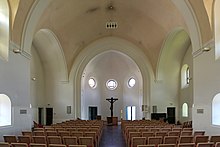Christ Church (Innsbruck)
The Christ Church is a Protestant church in the Saggen district in the state capital Innsbruck in Tyrol , which was built between 1905 and 1906. It is the main church of the Evangelical Superintendent of Salzburg and Tyrol and is a listed building .
history
In 1869 the "Protestant Faith Cooperative in Innsbruck" was established. Due to the resistance of the country, she was initially only allowed to hold domestic services. In 1875 the ministry allowed the establishment of Protestant parishes in Tyrol, on January 28, 1876 the "Evangelical parish A. and HB, Innsbruck" was constituted, a few days before the one in Merano . In 1879 the community acquired the abandoned kk normal school in the Kiebachgasse in the old town, in whose chapel the services were now held. In the following years the congregation grew to over 1000 members, so that a new church was planned from 1895. In 1896 Pastor Arnold Wehrenfennig set up a building fund, which was filled with donations, especially from the Protestant areas of Germany. The city of Innsbruck provided land in the newly built Saggen district. 86 designs were submitted to a competition, ultimately the architects Klemens Kattner and Gustav Knell were commissioned with the construction. In the spring of 1905, contractors broke ground, in July could topping-out ceremony will be committed on 20 May 1906, the church was opened with a church service.
In 1953 the church was repainted and frescoed by Toni Kirchmayr . In 1975 the altar, pulpit and benches were to be dismantled and armchairs were to be arranged in a semicircle around the extended chancel, but after resistance in the community the church was only renovated inside and outside and the paintings and Bible verses were whitewashed. In 2006 the Christ Church was finally converted into an "open evangelical center". For this purpose, the church interior was renovated and profoundly changed.
From 1962 to 1964 the Church of the Resurrection in Reichenau was built as the second Protestant church in Innsbruck. In 1968 it was spun off as a daughter parish from the mother parish of the Christ Church and in 1970 it became an independent parish.
architecture
The neo-Gothic church building also shows neo-Romanesque elements such as barrel vaults and round arches . The single-nave nave with a shallow transept has a tall, upward-tapering facade tower with a pointed helmet that dominates the Martin-Luther-Platz in front of it. The facade is characterized by the alternation of smooth, white plastered wall surfaces with stone-covered walls made of Höttinger Breccie , which summarize and accentuate individual wall areas and thus has echoes of the Heimat style . A semicircular baptistery is built to the north. The sculpture Head of Christ by Alexander Illitsch is located above the portal .
The interior of the church has a vestibule in the Emporenjoch with a groin vault , the main nave has a stitch cap vault , the lower transept a barrel vault , the choir a folding vault. The stained glass in the nave shows scenes from the Bible and the history of Protestantism , which were created by the Tyrolean Glass Painting Institute in 1912/1914 based on designs by the painter Bernard Rice . The stained glass in the north transept shows portraits of the reformers Zwingli , Luther and Melanchthon the company Zettler of Munich (1907). The glass painting in the baptistery shows baptismal scenes and ornamental windows in Art Nouveau style from the Tyrolean glass painting establishment (1911/1912) based on designs by A. Payr.
Furnishing
The marble pulpit was based on a design by Kattner and Knell. There was a crucifix by Alexander Illitsch on the altar.
During the redesign in 2006, the spatial impression of the church was greatly changed. The apse wall was provided with two large door openings and the chairs were removed and replaced with mobile seating. The steps in the presbytery as well as the altar and pulpit were also removed. The crucifix was moved.
organ
The organ was built in 1906 by GF Steinmeyer & Co. (Oettingen). The two-manual instrument has an automatic piano pedal in the second manual. It has 10 stops on two manuals.
|
|
||||||||||||||||||||||||||||||||||||
- Coupling : Suboctav copula II / I, manual copula II / I, pedal copula II / P, pedal copula for the 1st manual
Bells
Of the 4 bells (e´, g´, a´, h´) that hung in the church tower until 1942, only bell 3 rings in the tower today. For years there has been a plan to complete the bell again.
literature
- The art monuments of Austria. Dehio Tirol 1980 . Innsbruck: Saggen, Evangelical Christ Church, Richard-Wagner-Strasse - corner of Elisabethstrasse, p. 71.
- Reiner Sörries: By the grace of the emperor: Protestant church buildings in the Habsburg Empire . Böhlau, Cologne 2008, ISBN 978-3-412-20154-8 , pp. 79 .
- Ossi Keiler: 100 years of Christ Church. In: Die Brücke, community newspaper of the evangelical parishes Innsbruck and the surrounding area , No. 24, October 2006, pp. 5–7 ( PDF; 1.7 MB )
- Oswald Keiler: Evangelical in Tyrol (PDF; 358 kB)
- Christoph Hölz, Klaus Tragbar, Veronika Weiss (Hrsg.): Architectural guide Innsbruck . Haymon, Innsbruck 2017, ISBN 978-3-7099-7204-5 , pp. 111 .
- Schmid-Pittl, Wiesauer: Evangelical Christ Church. In: Tyrolean art register . Retrieved January 4, 2016 .
Web links
- Evangelical Parish AuHB Innsbruck-Christ Church
- Stained glass window of the Evangelical Christ Church in Innsbruck (1913) , cultural area Tyrol
Individual evidence
- ^ Office of the Tyrolean provincial government, cultural department (ed.): Culture reports from Tyrol 2007. 60th monument report. Innsbruck 2007, pp. 81–82 ( PDF; 10.7 MB )
- ↑ Information on the organ
- ^ Jörg Wernisch: Bell directory of Austria . Journal Verlag, Lienz 2011.
Coordinates: 47 ° 16 ′ 34.6 " N , 11 ° 24 ′ 6.2" E





